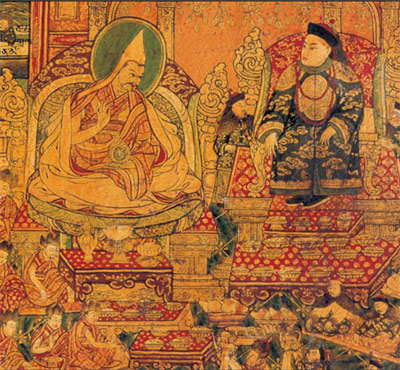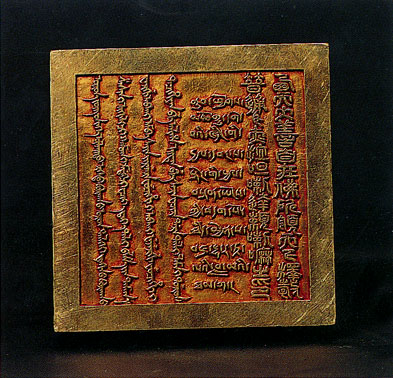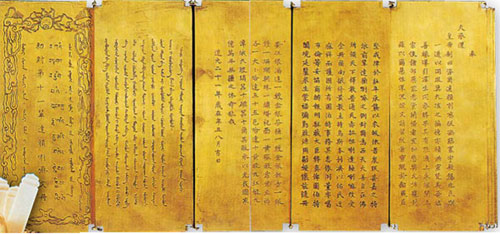The title of "Dalai Lama", was not granted by the Dalai Lama himself, or created by Tibetan Buddhism, or conferred by the old Tibetan ruling class and still less by any foreigners. The title was actually granted by the central government of China's dynasties and has multi-ethnic language features.
In the late Ming dynasty, Tibetan Buddhism proliferated into a number of sects, among which Sagya, Gagya and Gadang were most popular. However, many monks failed to follow Buddhist tenets; instead, they always served the devil by seeking fame and personal interests, disrespecting senior monks, indulging in entertainment, abducting, cheating or raping women. This resulted in grievances among the public in Tibet. At that time, Tsongkapa, a monk born in Qinghai Province, was learning Buddha Dharma in Tibet. Seeing all this, he felt that what these monks did was a long way from the actual requirements of Buddhism. Then he proposed a religious reform of all sects in Tibet, and vowed to create a new sect.
 |
|
The picture shows a fresco in the Potala Palace depicting that Emperor Shunzhi received the 5th Dalai Lama in Beijing. In 1652, or the 9th year of the reign of Emperor Shunzhi, Ngawang Lobsang Gyamco came to Beijing and was granted to be the 5th Dalai Lama plus a golden certificate of appointment and a gold seal of authority in the following year. (Xinhua file Photo)
|
In 1402 and 1406, Tsongkapa finished writing "Treaties of the Staged Enlightenment" and "Tantra in Tibet: The Grand Exposition of Secret Mantra" respectively, laying a theoretical basis for establishing the Gelug Sect. He thought that Buddhism believers ought to first respect Sakyamuni, the founder of Buddhism, be devoted to learning Sutras, Vinaya and Sastra of Tripitaka Sutra, as well as the three trainings of precepts, concentration, and insight. That is, to abide by taboos, to esteem the Buddhas and Patriarchs, to be immersed in studying the original meaning of Buddhist scriptures, to cultivate oneself according to Buddhist doctrine, to free oneself from vulgarity, to study intensively sutras of Mahayana and Hinayana, as well as to practice both Esoteric and Exotoric Buddhism.
Tsongkapa's reform soon won support from the Tibetan nobles and serf owners. In lunar January 1409, he held and presided over the first Pray for Blessing Dharma Assembly in Lhasa's Jokhang Temple. Later in the same year, Tsongkapa had the Ganden Monastery built and appointed himself the chief abbot there, marking the establishment of the Gelug Sect.
With an increasingly higher influence, the Gelug sprang up in Tibet and Qinghai. As a result, more monasteries were set up, such as Drepung, Sera and Tashilhunpo, laying a solid foundation for the development of the Yellow Sect.
|

|
|
The picture shows that Emperor Shunzhi granted the 5th Dalai Lama the title of "His Holiness Dalai Lama," and a golden seal of authority in 1653. (Xinhua file Photo)
|
Tsongkapa's success in the reformation enabled the Gelug to become the largest sect in Tibetan Buddhism. "Gelug" means that Buddhism believers should do good things and never do evil things. It is also called Huangjiao (the Yellow Sect) by the Han people because its followers always wear yellow hats.
Though it was the last to come into being, the Gelug had grown into the most powerful sect in Tibet with the energetic support of the central dynasty. This indicates that even a small sect would be able to become grand and influential in a region, so long as it gained support of the imperial court, the central government or a secular regime.
The title of "Dalai" first came from the third Dalai Lama Soinam Gyamco. "Gyamco" means the Sea in the Tibetan language, which is contained in the name of Dalai Lama of later generations.
In 1577, the 38th year of the reign of Emperor Jiajing of the Ming dynasty, Soinam Gyamco, Tsongkapa's third-generation disciple, came to Qinghai, by traveling thousands of miles from Tibet, to publicize the doctrine of the Gelug Sect. At that time, Mongolian noble Althan Khan, who ruled Qinghai, was a Buddhist who believed in Tibetan Buddhism the most. Hearing that Soinam Gyamco had arrived, he extended a rousing welcome to the dignitary and conferred him the title of "the Overseer of the Buddhist Faith Vajra-dhara Dalai Lama" to express appreciation of his wisdom and talents.
|

|
|
The picture shows the golden certificate issued by Emperor Daoguang to appoint Kezhol Gyamco the 11th Dalai Lama. (Xinhua file Photo)
|
The title has multi-ethnic language characteristics. "The Overseer of the Buddhist Faith" is the Han language. "Vajra-dhara" in Sanskrit means the ultimate Primordial Buddha, or Adi Buddha, according to the cosmology of Tibetan Buddhism. "Dalai" in the Mongolian language means the sea, and "Lama" in Tibetan means Living Buddha. All the best words in multi-ethnic languages had been granted to Soinam Gyamco.
Thanks to the support of the mighty Mongolian Khan, the newly-established Gelug Sect was able to stand firm in Tibet. Then the titles of "the first and the second Dalai Lama" were given to the former generations.
In 1653, the 10th year of the reign of the Emperor Shunzhi of the Qing dynasty, the 5th Dalai Lama, who had reached Beijing in the previous year, was granted an honorific title plus a golden certificate of appointment and a golden seal of authority by the Qing imperial court. For the first time the Dalai Lama had the administrative power as authorized by the central government. As a result, the Dalai Lama became a principal leader of theocracy in Tibet, which integrated administrative and religious powers.
Having been imperially acknowledged and granted the authority over Tibet since then, almost all the Dalai Lamas of later generations, except for the 14th Dalai Lama, were patriotic, loyal to the central government, and devoted to safeguarding the national unity. What people could not understand is that now that every Dalai Lama was the reincarnation of the late Living Buddha, why the patriotic quality wasn't passed to the 14th?
In fact, what the 14th Dalai Lama loves is his personal reputation, personal status and old Tibetan local regime practicing a feudal serfdom under the theocracy. Since he fled to India in 1959, the 14th Dalai Lama has been depending on the western countries for survival and those politicians with ulterior motives who can support his living, to win his so-called honor, status and obtain more funds from them. How despicable it is that Dalai, a previously esteemed religious leader in Tibet, has been reduced into a card of others chosen to play in the game!